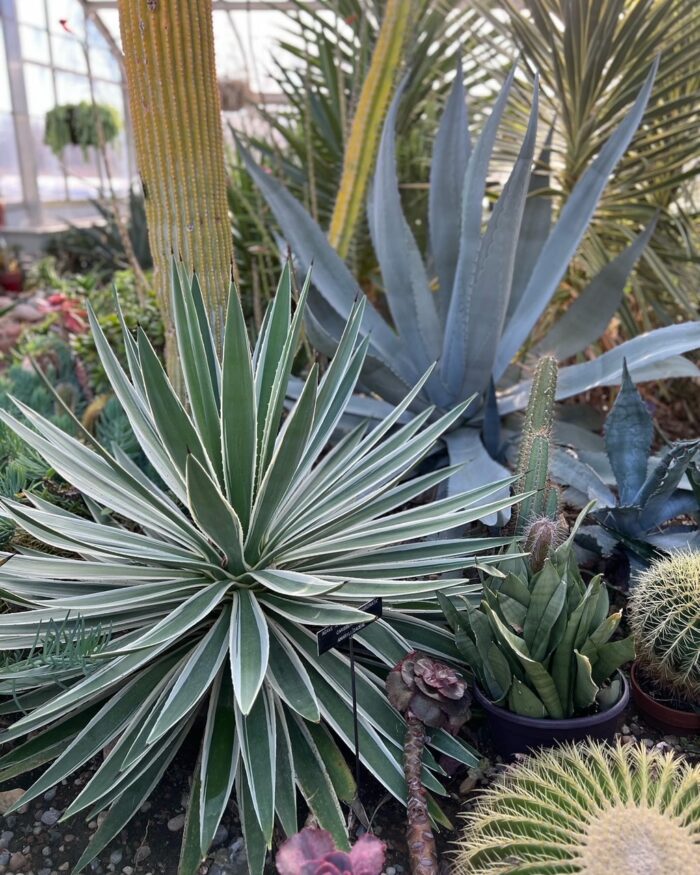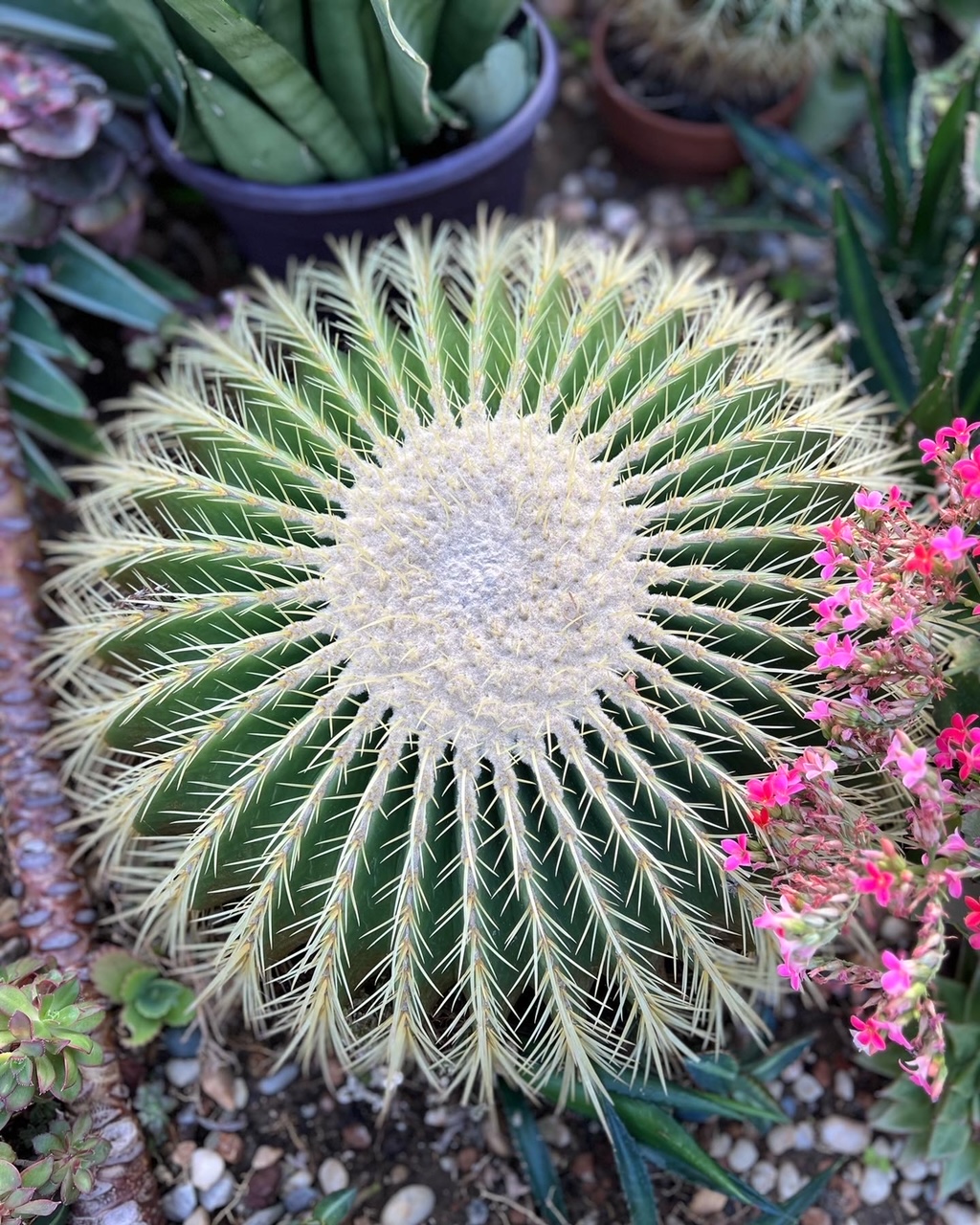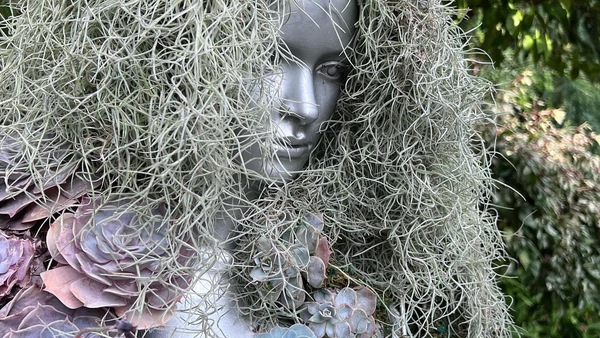Cherry Ong is taking us back to the conservatory at Centennial Park in the Toronto area. Today we’re on a visit to the arid house, which is full of plants from around the world that are adapted to dry and desert environments.
Arid doesn’t mean boring or empty. This conservatory is full of a huge range of forms and plant shapes that fill every inch with something worth looking at.
Ponytail palm (Beaucarnea recurvata, Zones 10–12) is often sold as a houseplant, but given ample space it will grow into a big dramatic plant like this. The swollen trunk serves to store water for dry seasons.
 You can’t have an arid house without cacti. This family of plants is native to the Americas. The swollen stems store water, and the spines keep hungry—and thirsty—animals from munching on them. Those practical adaptations also turn them into living sculptures.
You can’t have an arid house without cacti. This family of plants is native to the Americas. The swollen stems store water, and the spines keep hungry—and thirsty—animals from munching on them. Those practical adaptations also turn them into living sculptures.
Mother-of-thousands (Kalanchoe, Zones 10–12 or as a houseplant) has attractive succulent leaves, but these nodding, bell-shaped flowers are beautiful, both when fresh and salmon-orange, and as they age and fade to pink.
Agaves (Agave species, hardiness varies by variety) are another American succulent that is popular in arid displays for their huge leaves, which are often colored blue or even variegated.
The iconic golden barrel cactus (Echinocactus grusonii, Zones 9–12) is hugely popular in dry, warm landscapes but is endangered in the wild due to habitat destruction for agriculture and grazing.
Aloe is an African genus of succulents with many different species, ranging from small rosettes to tall ones like this with their beautiful succulent foliage.
This is a beautiful cactus, which I think is a species of Mammillaria.
A tower of small succulents makes a dramatic statement in the arid house.
Have a garden you’d like to share?
Have photos to share? We’d love to see your garden, a particular collection of plants you love, or a wonderful garden you had the chance to visit!
To submit, send 5-10 photos to gpod@taunton.com along with some information about the plants in the pictures and where you took the photos. We’d love to hear where you are located, how long you’ve been gardening, successes you are proud of, failures you learned from, hopes for the future, favorite plants, or funny stories from your garden.
Have a mobile phone? Tag your photos on Facebook, Instagram or Twitter with #FineGardening!
Do you receive the GPOD by email yet? Sign up here.
Fine Gardening Recommended Products
The Crevice Garden: How to make the perfect home for plants from rocky places
Fine Gardening receives a commission for items purchased through links on this site, including Amazon Associates and other affiliate advertising programs.
A crevice garden replicates the environmental conditions of mountain tops, deserts, coastlines, and other exposed or rocky places on earth. These striking garden features provide perfect conditions for the plants native to these far-off places, bringing the cultivation of these precious gems within everybody’s reach.
Gardena 3103 Combisystem 12-Inch To 20-Inch Adjustable Metal Fan Rake Head
Fine Gardening receives a commission for items purchased through links on this site, including Amazon Associates and other affiliate advertising programs.
With adjustable tine spacing: suitable for raking coarse and fine material. Flexible, zinc-plated spring-steel prongs. Working width adjustable from 12-20 inches. Sold as head only, handle sold separately.
ARS Telescoping Long Reach Pruner
Fine Gardening receives a commission for items purchased through links on this site, including Amazon Associates and other affiliate advertising programs.
Telescopes from 4 to 7'. Cut and Hold (160) Blades. Drop forged blades for unsurpassed long lasting sharpness. Lightweight, 2.3 lbs., for continued use. Perfectly balanced for easy pruning.



 You can’t have an arid house without cacti. This family of plants is native to the Americas. The swollen stems store water, and the spines keep hungry—and thirsty—animals from munching on them. Those practical adaptations also turn them into living sculptures.
You can’t have an arid house without cacti. This family of plants is native to the Americas. The swollen stems store water, and the spines keep hungry—and thirsty—animals from munching on them. Those practical adaptations also turn them into living sculptures.


























Comments
Very nice . Too bad all plants can't grow everywhere . Nice collection of plants that most don't see in their outdoor gardens . I'm still very much a huge fan of personal outdoor gardens here in the U.S. Overall , we a bang-up "job" with our enthusiasm , which drives creativity and ultimately , great gardens ! Peace from the Mohawk Valley in NY .
Another nice tour, thanks Cherry Ong! Interesting to see how large a Ponytail palm can grow- I've only seen them as houseplants!
The only other place I've seen them tall and large was at Ganna Walska Lotusland. That visit then really heightened my appreciation of them. Sadly, my houseplant remains short.
Fun post Cherry!
Thank you.
Love that succulent tower - lovely!!!
Me too! They had 2 botanical mannequins right at the entrance in the tropical greenhouse. I sent photos to Joseph of those too.
I love this!!!! The many shapes and textures are so amazing and stunning in their beauty and the colors are delightful.
Great Golden Barrel! So squat, sweet & stout. Cacti are fun in how they exist in arid places and are so stalwart against loss of moisture.
Log in or create an account to post a comment.
Sign up Log in